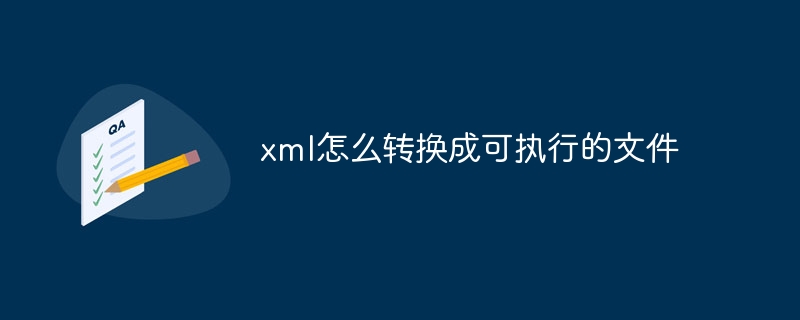How to convert xml into executable file
Use XSLT (Extensible Stylesheet Language Conversion) technology to implement XML to executable file conversion. Steps include: Install the XSLT processor to create an XSLT stylesheet to define the conversion rules to execute the conversion to generate the executable file

How to convert XML to executable
Converting XML to executable files requires the use of XSLT (Extensible Stylesheet Language Transformations) technology. XSLT is a conversion language that can be used to convert XML documents to other formats, including executable files.
step:
-
Install the XSLT processor:
- On a Windows system, install Microsoft XML Core Services (MSXML).
- On Linux and macOS systems, install the libxslt library.
-
Create an XSLT stylesheet:
- Write an XSLT stylesheet that describes how to convert an XML document to an executable file.
-
Perform a conversion:
- Use the XSLT processor to generate an executable file as input.
Detailed description:
Create an XSLT stylesheet:
XSLT stylesheets are usually in XML format. It contains the following elements:
- Template: Defines how to convert specific parts of an XML document.
- Variable: Stores temporary values used during conversion.
- Parameters: Allows the passing of values from outside to the stylesheet.
Perform a conversion:
XSLT conversions can be performed using command line tools or programming languages. A typical command line tool is xsltproc , which can be used like this:
<code>xsltproc style.xsl input.xml -o output.exe</code>
in:
-
style.xslis an XSLT stylesheet. -
input.xmlis an XML document. -
output.exeis the generated executable file.
Notes:
- The format and functionality of the generated executable depends on the XSLT stylesheet used.
- The XSLT conversion process can be complex, so it is recommended to understand the basics of XSLT before attempting to generate an executable.
The above is the detailed content of How to convert xml into executable file. For more information, please follow other related articles on the PHP Chinese website!

Hot AI Tools

Undresser.AI Undress
AI-powered app for creating realistic nude photos

AI Clothes Remover
Online AI tool for removing clothes from photos.

Undress AI Tool
Undress images for free

Clothoff.io
AI clothes remover

Video Face Swap
Swap faces in any video effortlessly with our completely free AI face swap tool!

Hot Article

Hot Tools

Notepad++7.3.1
Easy-to-use and free code editor

SublimeText3 Chinese version
Chinese version, very easy to use

Zend Studio 13.0.1
Powerful PHP integrated development environment

Dreamweaver CS6
Visual web development tools

SublimeText3 Mac version
God-level code editing software (SublimeText3)

Hot Topics
 1657
1657
 14
14
 1415
1415
 52
52
 1309
1309
 25
25
 1257
1257
 29
29
 1231
1231
 24
24
 Linux Architecture: Unveiling the 5 Basic Components
Apr 20, 2025 am 12:04 AM
Linux Architecture: Unveiling the 5 Basic Components
Apr 20, 2025 am 12:04 AM
The five basic components of the Linux system are: 1. Kernel, 2. System library, 3. System utilities, 4. Graphical user interface, 5. Applications. The kernel manages hardware resources, the system library provides precompiled functions, system utilities are used for system management, the GUI provides visual interaction, and applications use these components to implement functions.
 How to check the warehouse address of git
Apr 17, 2025 pm 01:54 PM
How to check the warehouse address of git
Apr 17, 2025 pm 01:54 PM
To view the Git repository address, perform the following steps: 1. Open the command line and navigate to the repository directory; 2. Run the "git remote -v" command; 3. View the repository name in the output and its corresponding address.
 How to run java code in notepad
Apr 16, 2025 pm 07:39 PM
How to run java code in notepad
Apr 16, 2025 pm 07:39 PM
Although Notepad cannot run Java code directly, it can be achieved by using other tools: using the command line compiler (javac) to generate a bytecode file (filename.class). Use the Java interpreter (java) to interpret bytecode, execute the code, and output the result.
 How to run sublime after writing the code
Apr 16, 2025 am 08:51 AM
How to run sublime after writing the code
Apr 16, 2025 am 08:51 AM
There are six ways to run code in Sublime: through hotkeys, menus, build systems, command lines, set default build systems, and custom build commands, and run individual files/projects by right-clicking on projects/files. The build system availability depends on the installation of Sublime Text.
 What is the main purpose of Linux?
Apr 16, 2025 am 12:19 AM
What is the main purpose of Linux?
Apr 16, 2025 am 12:19 AM
The main uses of Linux include: 1. Server operating system, 2. Embedded system, 3. Desktop operating system, 4. Development and testing environment. Linux excels in these areas, providing stability, security and efficient development tools.
 laravel installation code
Apr 18, 2025 pm 12:30 PM
laravel installation code
Apr 18, 2025 pm 12:30 PM
To install Laravel, follow these steps in sequence: Install Composer (for macOS/Linux and Windows) Install Laravel Installer Create a new project Start Service Access Application (URL: http://127.0.0.1:8000) Set up the database connection (if required)
 git software installation
Apr 17, 2025 am 11:57 AM
git software installation
Apr 17, 2025 am 11:57 AM
Installing Git software includes the following steps: Download the installation package and run the installation package to verify the installation configuration Git installation Git Bash (Windows only)
 How to set important Git configuration global properties
Apr 17, 2025 pm 12:21 PM
How to set important Git configuration global properties
Apr 17, 2025 pm 12:21 PM
There are many ways to customize a development environment, but the global Git configuration file is one that is most likely to be used for custom settings such as usernames, emails, preferred text editors, and remote branches. Here are the key things you need to know about global Git configuration files.




